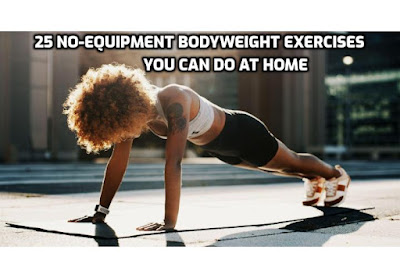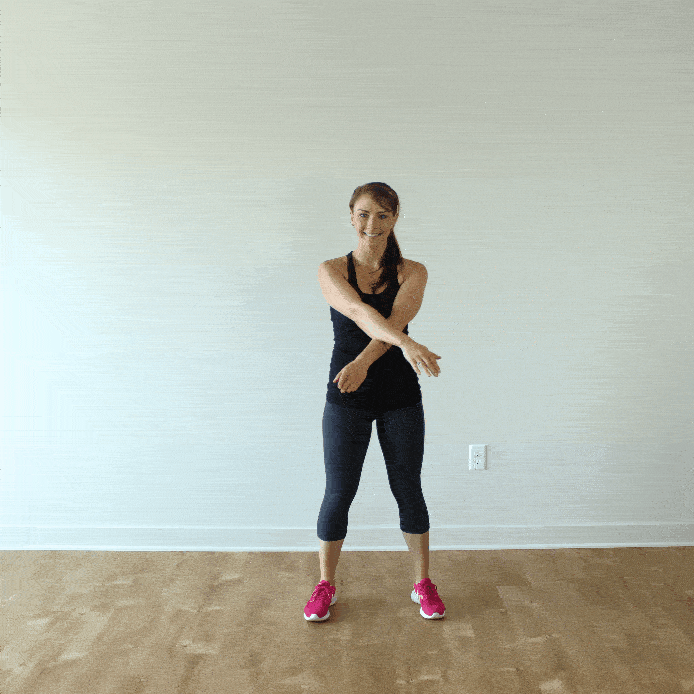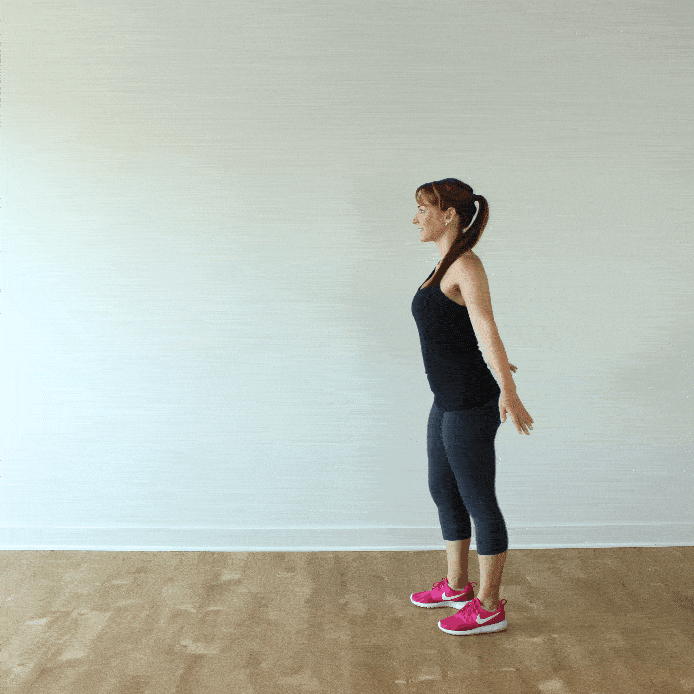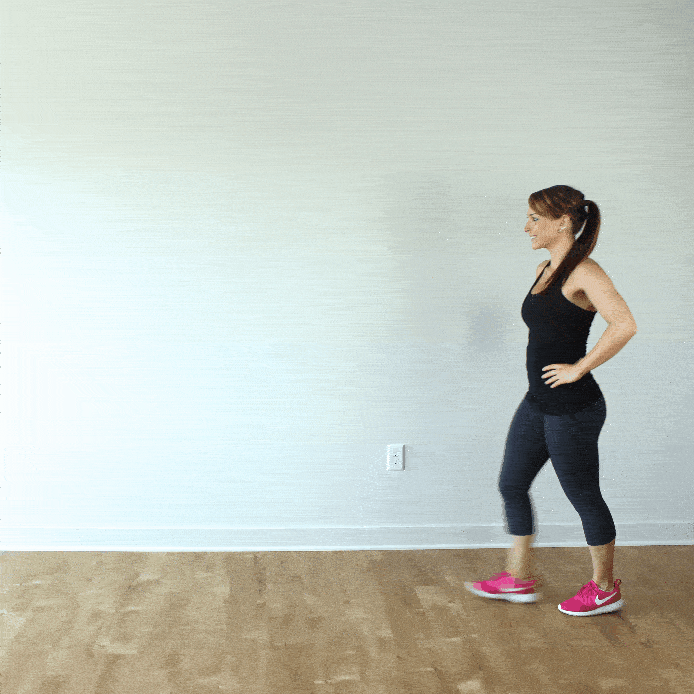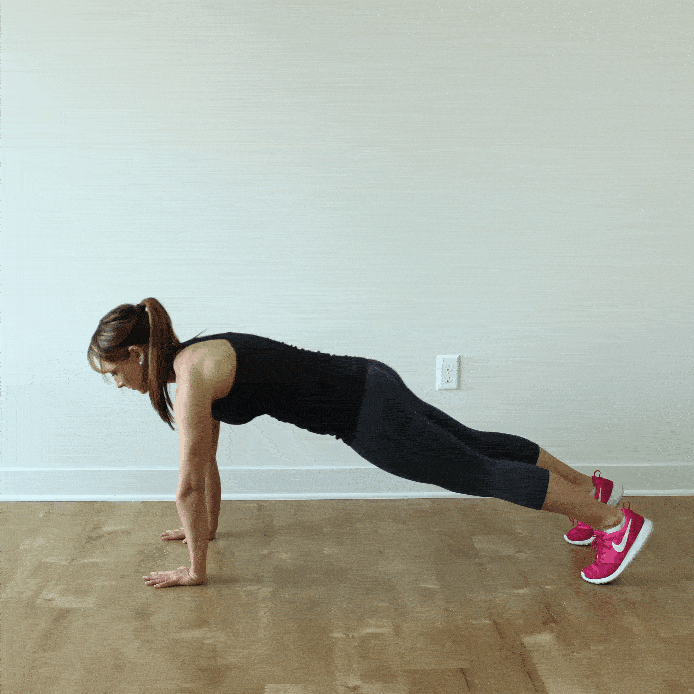Click HERE to Discover these 80 Keto-Friendly and Healthy Slow Cooker Recipes
No Equipment, No Problem – 25 Bodyweight Exercises You Can Do at Home
Who needs a gym when you can work out in your own living room? Here are 25 home bodyweight exercises to tone every inch!
We get it, some days it’s hard to leave the comfort of your own home.
As much as you want to get a workout in, you really just don’t want to drag yourself to the gym. So, we’ve compiled a list of 25 of the best home bodyweight exercises to tone and strengthen every muscle from head to toe.
Full Body & Cardio

1. Burpees – Start standing with feet together, lower into a deep squat position to bring your hands down to the floor. Jump your legs backwards into a full plank position on your hands. Jump your feet back into your low squat position and jump up, reaching your hands overhead. (For a modification, take out the jump and just stand up.)
2. Inchworm – Start by standing at the end of your mat with your feet hip-distance apart. Bend forward to reach your hands to the mat in a forward fold, reaching your hands flat on the mat (your knees may bend slightly). Walk your hands out about a foot at a time all the way out into a full plank position. Hold in the plank for a second or two and walk your hands all the way back into the forward fold, and repeat.
3. Jumping Jacks – Start standing with feet together and your arms by your sides. Jump the feet out wider than shoulder-width apart, as you bring the arms out to the side and overhead. As you jump the feet back together, bring the arms back down. Be sure to get the heels all the way down with each jump and repeat for 60 seconds. (I promise they won’t seem as easy as when you were 5 years old!)
4. High Knees – Start by jogging in place, focusing on bringing the knees up in front of you. As you get into the rhythm of things, start to go faster, bringing the knees higher and higher. Keep going for 30-60 seconds.
(Read: A Dynamic Stretching Warm-Up to Activate Your Muscles)
5. Skaters – Start by standing with most of your weight in your RIGHT leg as you bring your left foot behind you. Slightly lower down to help you propel yourself up, hopping your LEFT leg out to the side and landing on the left foot, bringing the right foot behind you. Continue hopping side to side, landing on one foot on each side. Complete 20 repetitions for a total of 30-60 seconds.
6. Mountain Climbers – Start in a plank position on your hands. Keeping your abs engaged and your shoulders directly over your hands, drive your RIGHT knee in towards your chest, using your abs to pull it in. Quickly reach that leg back and drive your LEFT knee in towards your chest. Go as quickly as you can while maintaining abdominal strength. Complete for 30 seconds to a minute.
7. Push-Up Jacks – Start as if you were going to be doing a standard push-up. As you lower down with your upper body, quickly jump your feet out wider than shoulder-width apart. As you push up, hop the feet back in, together.
Legs

8. Squats – Bring feet slightly wider than shoulder-width apart, and knees and toes slightly turned out. Place your hands behind your head and retract your shoulders together to open the chest. Squat down, sitting back as if sitting into a chair, keeping the weight in the heels and the chest open. Power through the heels to come back up to standing, squeezing the glutes at the top.
9. Jump Squats – Stand with feet a little wider than shoulder-width apart, and knees and shoulders very slightly turned out to the side. Lower down into a squat, keeping your weight in your heels. With power, drive through your heels to propel yourself up into a jump straight up. Land softly, rolling from the toes down to the heels, and sink down into your squat to repeat. Perform 15-30 jumps, depending on your ability.
10. Lunge – Start with both feet together and slightly shift your weight into your RIGHT leg. Keeping your balance, step your LEFT foot behind you onto your toes. Bend both knees to about 90 degrees and lower down into a lunge position. Keeping your weight in your front foot, press into the heel to engage the hamstrings and glutes to stand back up.
11. Single Leg Bridge – Lay on your back on a mat and bend your knees so your feet are flat on the ground. Bring your feet parallel and hip-distance apart. With your heels, close in towards your glutes. Extend your LEFT leg up to the ceiling. Using the RIGHT leg, press into the heel to lift the hips up, creating a straight line from your knee to your shoulders. Be sure to keep the hips parallel to the floor and squeeze the glutes. Lower the hips back down and repeat. Switch to complete all repetitions on the other side.
12. Single Leg Deadlift – Stand with feet together and holding dumbbells by your sides. Shift your weight into your RIGHT foot, making sure to keep most of the weight in the heel. Hinge at your hips, keeping your back straight and lift your LEFT leg so that your torso and leg are parallel to the floor.
You should feel a stretch in your RIGHT hamstring and the crown of your head should be reaching forward. Pressing through the heel and engaging the hamstring, straighten back up to standing. Repeat all repetitions on one side, then switch legs.
13. Wall Sit – Find an open, flat wall and stand next to it with your back flat against it. Walk your feet forward about 2 feet or so (about your own thigh-length away from the wall) and lower down into a squat position with a 90-degree bend in your knees.
Make sure to keep your knees in line with your toes, press your tailbone into the wall, and keep your shoulders back. To make this more advanced, you can hold a dumbbell in each hand or on your thighs. Hold for 30 seconds to start, and progress to 60 seconds as you become stronger.
Arms

14. Push-Up – Come into a full plank position on your hands, and position your hands directly under your shoulders for a narrow push-up, or wider than shoulder-width apart for a wide push-up. Lower down into a push-up with your elbows in by your sides for a narrow push-up, or out wide to the side with a 90-degree bend in your elbows. Press back up to the plank and repeat. This can be modified by lowering down to the knees if needed.
15. Lateral Plank Walks – Start in a full plank position with your hands directly under your shoulders and feet hip-distance apart. Slightly shift your weight into your left hand and leg as you step your RIGHT hand and foot out about six inches to the right. Slightly shift over to the right side of your body as you step the LEFT hand and foot to come back underneath you. Continue stepping your hands and feet over to the right for 5-10 “steps,” and then step back to the LEFT.
16. Alternating Shoulder Tap Planks – Starting in a full plank position, keep your hips as steady as possible as you reach your RIGHT hand to tap your LEFT shoulder. Place the RIGHT hand back into its starting position, and then tap the LEFT hand to the RIGHT shoulder. Continue alternating as fast as you can without wiggling the hips.
17. Military or Dynamic Plank – Starting in a basic plank position on your elbows, you will be pressing yourself up to a full plank. Place your RIGHT hand directly where your RIGHT elbow was to lift up, and as you do so place the LEFT hand where the LEFT elbow was. You should now be in a full plank. To lower back down, bend the RIGHT elbow and place it on the floor where the RIGHT hand was, and repeat with the LEFT. Aim to complete 10 repetitions with the RIGHT arm leading the movement, then repeat starting with the LEFT arm leading.
18. Pike/Handstand Push-up – This starts taking the decline push-up to another level. This push-up will focus primarily on the shoulders and can be performed in a pike position (shown), with feet elevated in a pike position (similar to a decline push-up), or in a handstand with your feet against a wall for support. If you want to get fancy and are strong enough, you could even do a freestanding handstand push-up (please only attempt this if you can do a handstand and hold it for a period of time).
For the pike push-up, start in a downward facing dog position, with a wide hand position and your weight shifted more into your hands. Look up at your belly button to keep your neck in line with your spine. Bend the elbows out to the side and lower until the crown of your head just hovers above the ground, then press back up.
Perform the same movement in an elevated pike position of a handstand position. Start with fewer repetitions and work your way up.
Core

19. Plank – Come onto hands and knees with your hands directly under your shoulders. Brace through your abdominals and extend your legs back, placing the balls of the feet on the mat behind you. Create a straight line from the crown of your head to your feet. Be sure not to let your lower back arch, and keep your abs tight the entire time. Hold for 30 seconds for beginners and work your way up to 60 seconds.
20. Side Plank – Lay on your RIGHT side, stacking your hips and feet. Position your bottom RIGHT elbow directly under your RIGHT shoulder. Lift your bottom hip off the ground to create a straight line in a plank. Your should be lifting from your bottom oblique and feel a slight pinch in the waistline. Reach your top hand towards the ceiling or place it on your top hip. Be sure to complete the side plank on both sides, you may notice one side is stronger than the other (that’s normal, but we want to fix that as much as possible). To modify this exercise, keep your bottom knee on the ground.
21. Straight Leg Crunch – Lying on your back, extend your arms and legs straight up to the ceiling. Pull your navel into your spine and use your abs to lift your head, neck, and shoulders off the mat to reach the hands towards the feet. With control, lower your head back down. If you need more support for your neck, place your hands behind your head, but be sure not to pull on the neck.
22. Bicycle – Lay on your back on the mat and place your hands behind your head. Bring your knees up in a 90-degree bend, with your knees directly over your hips. Using your abs, lift your chest and your head off the mat a few inches and rotate to the RIGHT, reaching your LEFT elbow to your RIGHT knee, and simultaneously reaching your LEFT leg out straight to hover off the mat. Come back into the center with your knees over your hips, and repeat on the other side.
23. Leg Lowers – This crunchless ab exercise really focuses on those lower abs, but as you perform this exercise you will feel all over those abs and even feel the muscles in the back help stabilize your torso. Lay on your back and raise your legs into the air. With control, lower your legs towards to floor but keep the lower back glued to the mat. You don’t have to go down too far, just be sure to keep the abdominals engaged. Use the lower abs to pull those legs back up.
24. Windshield Wipers – Lay on your back with your arms out in a “T” position and your legs extended straight up to the ceiling. Engage your abdominals and keep your shoulders glued to the floor as you let your legs drop over to the RIGHT a few inches, allowing your left hip to come slightly off the ground. As you feel like you just start to lose control, use your LEFT side obliques to pull the legs back up to the center, straight up. Repeat on the other side for one full repetition.
25. Superman – Laying on your stomach on your mat, extend your arms over your head with your palms facing down. Reach the crown of your head forward and let your nose hover an inch off the ground. Draw your shoulder blades down your back as you lift your arms and legs a few inches off the ground. Think about squeezing your glutes and pulling your shoulders together to engage your entire back. Lower your arms and legs, and repeat.
Watch this video – No Equipment Bodyweight Workout – At Home Core, Butt and Thighs Workout
Written by Deanna Dorman
Author Bio:
Deanna is an ACE® certified personal trainer, Balanced Body® Pilates instructor, and NASM® Fitness Nutrition Specialist. She is passionate about inspiring others to lead a healthier lifestyle through fun workouts and healthy food. When she’s not creating new workouts and recipes for her blog The Live Fit Girls she enjoys running with her two dogs and traveling.
A lot of people have gotten results from the Keto diet, and enjoyed the foods that it has to offer. However, many of the people who are following this diet have a hard time finding the recipes that they need, especially ones that are quick and easy to complete.
Fortunately, Kelsey Ale, noticed this problem, and decided to do something about it. She’s found that making recipes in a slow cooker gives you meals which are not only delicious, but also take very little time to make. Mostly you just put a few simple ingredients in the slow cooker, and let it do the rest.
To find out more, click on – Keto Slow Cooker Cookbook
